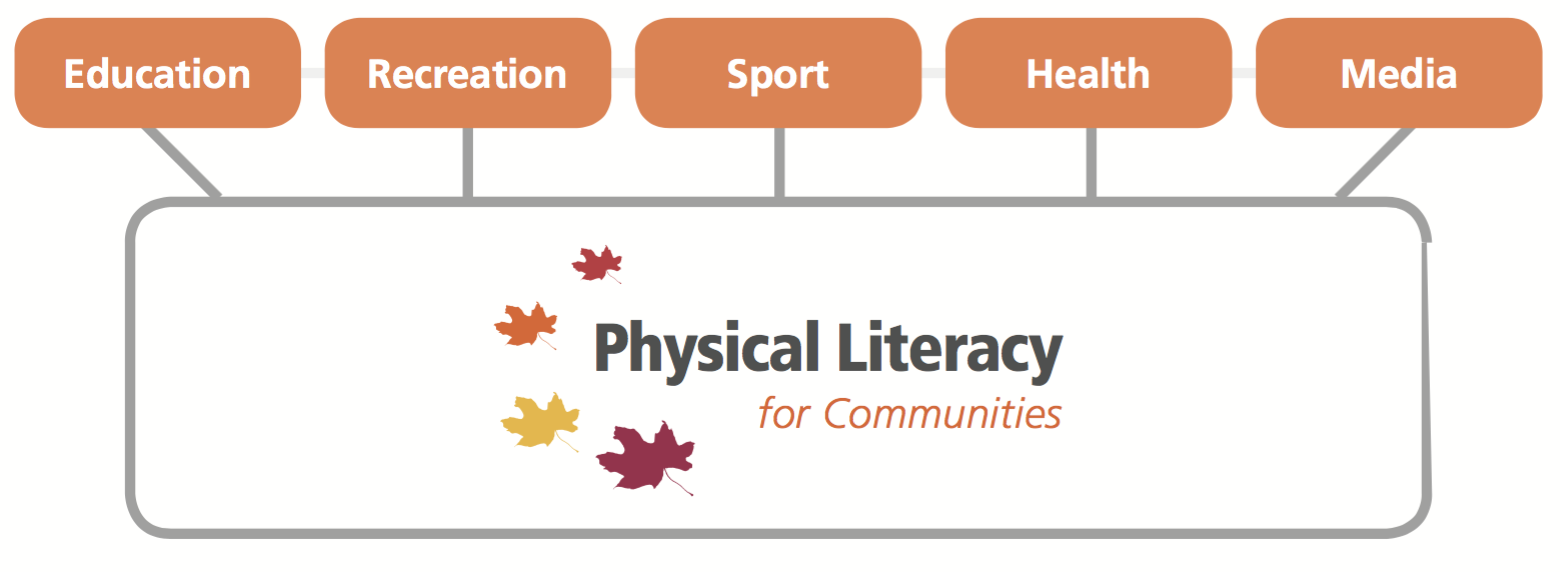
The Issue
The new generations are at risk of a shorter lifespan than their parents if we don’t act now. The risks are: poor quality of physical, cultural, intellectual, social, and mental health.
The Solution
The solution Physical Literacy for Life is proposing is the alignment of five key community sectors, cooperating to deliver the what, the why, and how of physical literacy. The solution is supporting national, provincial, and municipal stakeholders supporting knowledge transfer and implementation of Physically Literate Communities. Physical Literacy for Life is aggregating years of sectoral program, product, and service knowledge in order to provide a clear, concise, and intentional healthy community pathway.

What does Physical Literacy in a Community Look Like?
Objectives
- To educate and activate local decision makers, then build capacity by training leaders
- To develop physical literacy in multiple settings and sectors
- To provide opportunities for communities, including persons from under-represented or marginalized populations, to actively participate in the project
- To positively impact community health and well being
Frequently Asked Questions
- What is Physical Literacy for Communities?
- The Physical Literacy for Communities program is a unique guiding framework with the purpose of improving the development of physical literacy, which leads to increased physical activity positively impacting health and well-being.
- Why would Physical Literacy for Communities be good for my community?
- Physical Literacy for Communities acts as a catalyst to connect sectors and develop physical literacy which leads to improved levels of physical activity and health in the community.
- What do we need to have in place or establish to deliver Physical Literacy for Communities in our community?
- A cross sectoral Physical Literacy for Communities working group that represents the five main sectors of Health, Sport, Recreation & Community Agencies, Education, and Media. These are commonly known as PLAYGroups or equivalent. There are also sector working groups who action Physical Literacy for Communities within their specific sectors as well as cross-sectoral. All members must have long-term planning, vision, and commitment.
- Who makes up the cross sectoral Physical Literacy for Communities working group?
- The Physical Literacy for Communities working group is made up of community champions that are invested in physical literacy. The (Link to the Key Stakeholders document) provides an outline for key members to sit at the table. Each community will have varying capacity across their sectors but a goal of 2-3 representatives for each sector is important (ie. 10-15 people in total).
- What are the products and services that make up Physical Literacy for Communities?
- The Physical Literacy for Communities process is a blend of core services and customizable services. Each community will progress through the core services of workshops, measurement, and evaluation. The Physical Literacy for Communities working group will also be able to select additional services from the Physical Literacy for Communities menu. Your Sport for Life mentor will explain all services and support creation of a unique plan that best reflects the needs of your specific community while also maintaining a core level of consistency with other Physical Literacy for Communities.
- What is the role of the community mentor?
- Each community has a designated Sport for Life mentor to support the Physical Literacy for Communities process and delivery. The mentor acts as a facilitator, a content expert for physical literacy and quality sport, a collective impact guide, and a measurement/evaluation support. They are also available for consultations with the community, can mediate conflict, and will garner further supports when needed.
- How is leadership distributed around the working group?
- As this is a cross-sectoral initiative, the goal is shared leadership and accountability for Physical Literacy for Communities group actions. This can include rotating chairs for meetings as an example. As each organization comes to the table with varying organizational capacity, the group members will establish a Terms of Reference to determine how leadership and accountability is shared.
- What do we do if we run into problems?
- Your group will have access to community mentors and the Sport for Life team at large all the way throughout the process. Your community mentor is equipped to help with any area of the Physical Literacy for Communities process and will be able to support when there are challenges presented.
- Does the Physical Literacy for Communities process use a collective impact approach?
- The Physical Literacy for Communities process aligns directly with a collective impact approach. Your community mentor will explain the alignment in detail and will provide resources to support everyone’s understanding of collective impact.
- Won’t all this sector collaboration slow me down?
- In order to meaningfully address the inactivity crisis, a cross-sectoral approach is absolutely essential. It’s true that collaborating can lead to some delays in the beginning, but ultimately, we will be able to go farther together than we could ever go if we continue to work in silos.
- How will we measure our progress?
- Our measurement and evaluation tool is the Milestones document. This document, which is established in the first three months of the Physical Literacy for Communities process, will guide our actions and track our progress to ensure we are reaching our targets and timelines. The group will hold each other accountable to achieving their Milestones through monthly updates, frequent check-ins, collaboration, and community mentor support.
For more information on Physical Literacy for Communities, please contact info@physicalliteracy.ca.
 Physical Literacy for Communities—British Columbia Initiative
Physical Literacy for Communities—British Columbia Initiative
Supported by the BC Physical Activity Strategy and delivered by Sport for Life, this community initiative seeks to improve the development of physical literacy in British Columbia and increase physical activity to positively impact health and well-being in selected communities across the province.
This initiative provides targeted funding of up to $50,000 over a two-year period, along with mentorship and support, to approximately 17 BC communities toward the collaborative design and multi-sector development of physical literacy. The key phases of the initiative are Educate, Train and Mentor.

Physical Literacy for Communities—Further Canadian Communities
Physical Literacy for Communities is a program of Sport for Life. The purpose of the program is to support community leaders across the country who are committed to creating and sustaining healthy, active communities through the development of physical literacy to improve physical activity and quality sport
The Physical Literacy for Communities engagement strategy provides a focused framework that connects and aligns physical activity partners and initiatives. The program provides support, products & services through education, training and mentorship using a sustainable community development model.
 Physical Literacy for Communities—Public Health Agency of Canada Project
Physical Literacy for Communities—Public Health Agency of Canada Project
The national Physical Literacy for Communities (PL4C) initiative is being scaled to include new Physical Literacy for Communities communities in Northern BC, Alberta, Quebec and Atlantic Canada. It is a long-term approach to supporting people and creating healthy communities.
An initiative of the Public Health Agency of Canada (PHAC), delivered by Sport for Life, PHAC PL4C is a 36-month project designed to support the development of physical literacy in 150,000 children and youth aged 2-18 across Canada, beginning in 2022.
